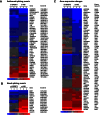A genome landscape of SRSF3-regulated splicing events and gene expression in human osteosarcoma U2OS cells
- PMID: 26704980
- PMCID: PMC4770227
- DOI: 10.1093/nar/gkv1500
A genome landscape of SRSF3-regulated splicing events and gene expression in human osteosarcoma U2OS cells
Abstract
Alternative RNA splicing is an essential process to yield proteomic diversity in eukaryotic cells, and aberrant splicing is often associated with numerous human diseases and cancers. We recently described serine/arginine-rich splicing factor 3 (SRSF3 or SRp20) being a proto-oncogene. However, the SRSF3-regulated splicing events responsible for its oncogenic activities remain largely unknown. By global profiling of the SRSF3-regulated splicing events in human osteosarcoma U2OS cells, we found that SRSF3 regulates the expression of 60 genes including ERRFI1, ANXA1 and TGFB2, and 182 splicing events in 164 genes, including EP300, PUS3, CLINT1, PKP4, KIF23, CHK1, SMC2, CKLF, MAP4, MBNL1, MELK, DDX5, PABPC1, MAP4K4, Sp1 and SRSF1, which are primarily associated with cell proliferation or cell cycle. Two SRSF3-binding motifs, CCAGC(G)C and A(G)CAGCA, are enriched to the alternative exons. An SRSF3-binding site in the EP300 exon 14 is essential for exon 14 inclusion. We found that the expression of SRSF1 and SRSF3 are mutually dependent and coexpressed in normal and tumor tissues/cells. SRSF3 also significantly regulates the expression of at least 20 miRNAs, including a subset of oncogenic or tumor suppressive miRNAs. These data indicate that SRSF3 affects a global change of gene expression to maintain cell homeostasis.
© The Author(s) 2015. Published by Oxford University Press on behalf of Nucleic Acids Research.
Figures








References
-
- Pittman A.M., Fung H.C., de S.R. Untangling the tau gene association with neurodegenerative disorders. Hum. Mol. Genet. 2006;15:R188–R195. - PubMed
Publication types
MeSH terms
Substances
Grants and funding
LinkOut - more resources
Full Text Sources
Other Literature Sources
Molecular Biology Databases
Research Materials
Miscellaneous

